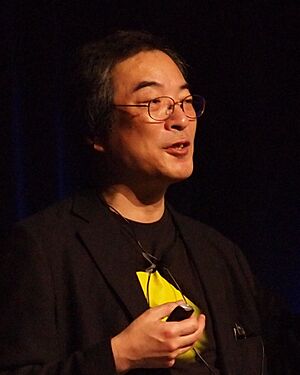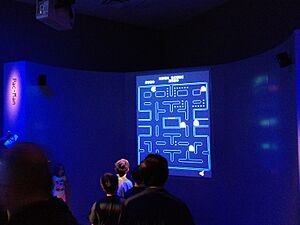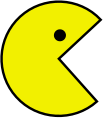Pac-Man facts for kids
Quick facts for kids Pac-Man |
|
|---|---|

North American arcade flyer
|
|
| Developer(s) | Namco |
| Publisher(s) |
|
| Designer(s) | Toru Iwatani |
| Programmer(s) | Shigeo Funaki Shigeichi Ishimura |
| Artist(s) | Hiroshi Ono |
| Composer(s) | Shigeichi Ishimura Toshio Kai |
| Series | Pac-Man |
| Platform(s) |
Arcade
Atari 2600, Atari 5200, Apple II, Atari 8-bit, MSX, NES, Commodore 64, VIC-20, Intellivision, ZX Spectrum, TI-99/4A, IBM PC, Game Boy, Game Gear, Game Boy Color, Neo Geo Pocket Color, Mobile phone, Game Boy Advance, iPod Touch, Xbox 360, PlayStation 4, Xbox One, iOS, Android
|
| Release date(s) |
|
| Genre(s) | Maze |
| Mode(s) | Single-player, multiplayer |
Pac-Man is a super famous arcade video game that first came out in 1980. It was made by a Japanese company called Namco. In North America, another company, Midway Manufacturing, helped release it.
In the game, you control a round, yellow character named Pac-Man. Your goal is to eat all the small dots scattered around a maze. But watch out! Four colorful ghosts are chasing you. These ghosts are Blinky (red), Pinky (pink), Inky (cyan), and Clyde (orange). If a ghost touches Pac-Man, you lose a life.
Luckily, there are special, larger flashing dots called "Power Pellets." When Pac-Man eats one of these, the ghosts temporarily turn blue and look dizzy. This is your chance to eat them for extra points! After you eat a ghost, its eyes zoom back to the center of the maze to "regenerate" and come back to chase you again.
Pac-Man quickly became a huge hit all over the world. It led to many other games, toys, TV shows, and even a popular song called "Pac-Man Fever". Pac-Man himself became the official mascot for Namco, and later for Bandai Namco Entertainment. It's still one of the most successful and well-known video games ever made!
Contents
How to Play Pac-Man
Pac-Man is an action game where you guide Pac-Man through a maze. Your main goal is to eat every single dot in the maze. Once all dots are gone, you move on to the next level!
Meet the Ghosts
The four ghosts, Blinky, Pinky, Inky, and Clyde, each have their own special way of trying to catch Pac-Man.
- Blinky (red) is the most direct; he usually chases Pac-Man right away.
- Pinky (pink) and Inky (cyan) try to get in front of Pac-Man, often working together to trap him.
- Clyde (orange) is a bit trickier; he sometimes chases Pac-Man and sometimes runs away.
If a ghost catches Pac-Man, you lose one of your lives. The game ends when you run out of lives.
Power-Ups and Bonuses
In each corner of the maze, you'll find a large, flashing "Power Pellet." Eating one of these makes the ghosts turn blue and run away from Pac-Man. While they are blue, you can eat them for bonus points! The more blue ghosts you eat in a row, the more points you get. After a short time, the blue ghosts will flash white before turning back to their normal colors and chasing you again.
Sometimes, a bonus item like a fruit will appear in the middle of the maze. Eating these items gives you extra points too! There are also two "warp tunnels" on the sides of the maze. Pac-Man and the ghosts can use these to instantly travel to the other side of the screen. Ghosts move a bit slower when they go through these tunnels.
As you play more levels, the game gets harder. The ghosts become faster, and the Power Pellets don't last as long. Eventually, on level 256, there's a special glitch that makes the level impossible to finish. This is known as a "kill screen."
How Pac-Man Was Made

The idea for Pac-Man started in early 1979. A young designer named Toru Iwatani at Namco wanted to create a new kind of video game. Most games at the time were about war or sports, and they mostly appealed to boys. Iwatani wanted to make a game that everyone, including girls, would enjoy. He thought that if arcades had more friendly games, more families would visit them.
The Idea Behind the Game
Iwatani thought about things women liked to do, and he decided to make a game about eating! The name Puck Man came from a Japanese phrase, paku paku taberu, which sounds like someone quickly opening and closing their mouth to eat.
The famous Pac-Man character was inspired by a pizza with one slice missing. Iwatani also said he shaped Pac-Man by rounding out the Japanese symbol for "mouth," which is kuchi (口).
Designing the Characters
The ghosts were designed to be cute and colorful, not scary. They have bright colors and big, expressive blue eyes. Iwatani was inspired by friendly ghost characters from cartoons like Casper the Friendly Ghost. Even though they are the bad guys, he wanted them to look appealing.
Each ghost was given a unique "personality" or way of moving. This made the game more interesting and challenging. For example, Blinky always chases you, while Pinky tries to ambush you. Inky uses a more complex plan, and Clyde sometimes chases and sometimes runs away.
The idea for the Power Pellets came from the cartoon character Popeye the Sailor, who gets super strong after eating spinach. The bonus fruits were inspired by symbols on slot machines. The sounds in the game, like Pac-Man's eating noise, were added last.
Pac-Man's Big Debut
The game was first tested in Japan in May 1980. People who didn't usually play video games really liked it because it was easy to learn. It was released across Japan in July.
When Namco decided to bring the game to the United States, they made a few changes. The biggest change was the name. The original Japanese name was Puck Man. But Namco was worried that people might vandalize the arcade machines by changing the "P" to an "F". So, they changed the name to Pac-Man, which was closer to the original Japanese sound.
Midway Manufacturing helped distribute Pac-Man in North America, and it quickly became a massive success.
Playing Pac-Man at Home
Because Pac-Man was so popular, it was made available on many different home video game systems and computers. One of the most famous home versions was for the Atari 2600 in 1982. While it sold millions of copies, some players felt it didn't look exactly like the arcade game.
Over the years, Pac-Man has been released on almost every game console imaginable! This includes the NES, Game Boy, mobile phones, Xbox 360, PlayStation 4, Xbox One, and even the Nintendo Switch. You can also find Pac-Man included in many game collections, letting new generations enjoy the classic.
Pac-Man's Amazing Impact
Pac-Man has left a huge mark on video game history and pop culture. Guinness World Records has given the Pac-Man series several awards, including "Most Successful Coin-Operated Game." In 2010, the game's creator, Toru Iwatani, received a certificate for Pac-Man having the most arcade machines installed worldwide.
In 2009, Guinness World Records even named Pac-Man the most recognizable video game character in the United States! In 2015, Pac-Man was added to the World Video Game Hall of Fame. The game and its character became a symbol of the 1980s.
Pac-Man in Pop Culture
The game has inspired many real-life events, like "Pac-Manhattan," where people played a giant game of Pac-Man in New York City. The idea of Pac-Man has even influenced business terms, like the "Pac-Man defense" in business, which means turning a difficult situation around.
In 2012, Pac-Man was added to the permanent collection of the Museum of Modern Art (MoMA) in New York City, showing how important it is as a piece of art and design. During the closing ceremony of the 2016 Summer Olympics, a short video showed Pac-Man and the ghosts racing, highlighting Tokyo as the next host city.
Pac-Man Merchandise
There have been tons of Pac-Man products over the years! In the 1980s, you could find Pac-Man bumper stickers, jewelry, bicycles, breakfast cereals, popsicles, T-shirts, and toys. Even 7-Eleven stores sold Pac-Man themed cups and other items. Recently, in 2023, 7-Eleven brought back Pac-Man themed products, including special coffee and Slurpee flavors named after the ghosts!
Lego also released a special set of a Pac-Man arcade machine, complete with Lego versions of Pac-Man and the ghosts.
Pac-Man on TV and in Movies
Pac-Man has appeared in several TV shows and movies. An animated TV series produced by Hanna–Barbera aired from 1982 to 1983 and was very popular. Later, a computer-animated series called Pac-Man and the Ghostly Adventures aired from 2013 to 2015.
In movies, Pac-Man and the ghosts appeared in Pixels (2015), where the game's creator, Toru Iwatani, even had a small role. They also showed up in Guardians of the Galaxy Vol. 2 (2017) and the animated Disney movies Wreck-It Ralph and Ralph Breaks the Internet. The game is also mentioned in the book Ready Player One.
The popular song "Pac-Man Fever" by Buckner & Garcia was a huge hit in 1981, selling millions of copies. Other musicians, like Aphex Twin and Gorillaz, have also made music inspired by Pac-Man.
Record-Breaking Pac-Man
A "perfect score" in the original Pac-Man arcade game is 3,333,360 points. To get this, a player must eat every single dot, Power Pellet, fruit, and blue ghost on the first 255 levels without losing a life. Then, they must use all six of their lives to get the highest possible score on the special level 256.
The first person to achieve a publicly witnessed perfect score was Billy Mitchell in 1999. For a time, some record-keeping groups decided not to recognize his score. However, in 2020, Guinness World Records officially recognized his 1999 perfect score again. As of July 2020, several other players have also achieved perfect scores on original arcade machines. The fastest perfect score was achieved by David Race in 3 hours, 28 minutes, and 49 seconds.
More Pac-Man Adventures
Pac-Man started a whole series of games that continues to this day! The first big follow-up was Ms. Pac-Man, released in 1982. This game introduced a female Pac-Man character and new mazes. It became just as popular as the original!
Many other Pac-Man games have been made, including Super Pac-Man (1982), Pac-Mania (1987) which had an isometric view, and 3D platformers like Pac-Man World (1999). More recently, games like Pac-Man Championship Edition (2007) brought new, fast-paced fun to the classic maze game.
In 2010, for the game's 30th anniversary, Google changed its homepage logo to a playable version of Pac-Man for a weekend. It was played by over a billion people! In 2017, Google even let users play Pac-Man on Google Maps for April Fools' Day. In 2020, a Pac-Man-themed game pack was released for Minecraft.
Images for kids
See also
 In Spanish: Pac-Man para niños
In Spanish: Pac-Man para niños



